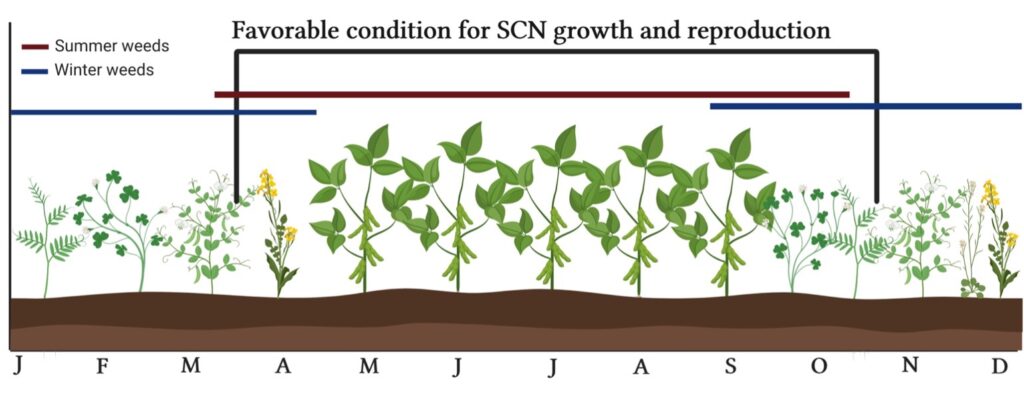Weeds as hosts of SCN
Continuing our Soybean Pathology 101 Series…
I am sure you have plenty of reasons to dislike weeds on your farm. Here is another one. As part of a project in graduate school, I completed a review of the scientific literature covering weeds as hosts of the soybean cyst nematode (SCN). In that review (linked below), I found that SCN can reproduce in over 100 weed species, including purple deadnettle (Lamium purpureum L.), henbit (Lamium amplexicaule L.), field pennycress (Thlaspi arvense L.), shepherd’s-purse (Capsella bursa-pastoris (L.) Medik), common chickweed (Stellaria media (L.) Vill.), smallflowered bittercress (Cardamine parviflora L.), common mallow (Malva neglecta Wallr.), white clover (Trifolium repens L.), Canada thistle (Cirsium arvense (L.) Scop.), common cocklebur (Xanthium strumarium L.), and many others. You can find a complete list of these weed species in the linked article below. Some of these weeds are better hosts than others, meaning they can support more or less SCN reproduction.
The dynamics of weeds and SCN
If you remember my first blog discussing the disease triangle, a plant host, a pathogen, and a favorable environment are required to initiate a plant disease. Soybean is the primary host of SCN, but this pathogen can also reproduce and complete its life cycle in secondary hosts, such as weeds. The number of SCN eggs per plant in secondary hosts is much lower than in soybean but still significant in the context of SCN management.
If you look at the figure below, you can see that the minimum temperatures required by SCN (>59F) in our region are somewhere between March/April and around November. There are some windows in the early and late-season when the temperatures are above that required by the SCN, but soybean is either not planted or has already harvested during these times. SCN may use these alternative hosts to reproduce in these windows and in non-soybean years, even though they are not the optimal choice.

Figure 1: Dynamics of SCN and weeds in soybean cropping systems (Image credit: Leo Rocha; Adapted from Johnson et al., 2008).
Take home message
If you are rotating soybean with corn (a non-host of SCN), SCN may use weeds as alternative hosts. An efficient weed management program will make the effect of crop rotation on SCN even more impactful, as that nematode will not have a plant host to reproduce. Therefore, weed management can contribute to your SCN management program when paired with crop rotation, resistant varieties, seed-applied nematicides, and so on.
The link to the full research article below if you want to dive into the topic.
Sources
Rocha, L. F., Gage, K. L., Pimentel, M. F., Bond, J. P., and Fakhoury, A. M. 2021. Weeds hosting the soybean cyst nematode (Heterodera glycines Ichinohe): Management implications in agroecological systems. Agronomy 11:146. Article / Google Scholar
Johnson, W.G.; Earl Creech, J.; Mock, V.A. 2008. Role of winter annual weeds as alternative hosts for soybean cyst nematode. Crop Management 7, 1–9. Article / Google Scholar


 and then
and then